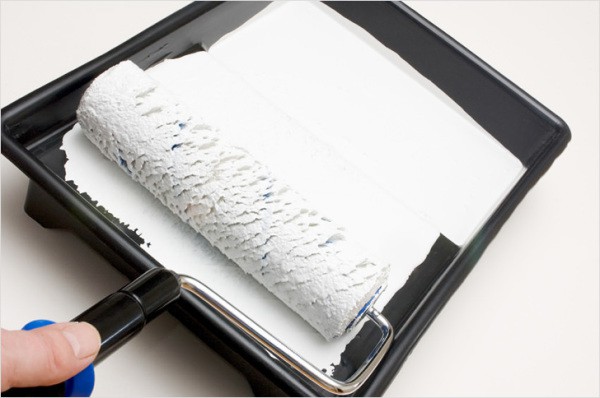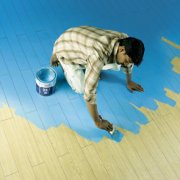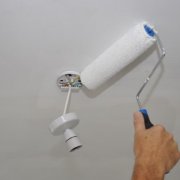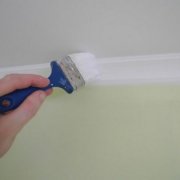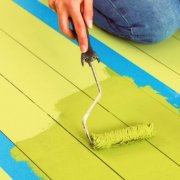How to paint with a roller: professional advice
Which roller is best for acrylic paint, water-based paint or any other when coating the surface is of interest to many who are going to carry out repairs in their home. Such tools allow you to work on a large area and at the same time limit the consumption of paints and varnishes, while observing the desired layer thickness and uniformity of coating.
Before starting work with your own hands, it is necessary to carefully study the technology of painting with a roller in order to achieve the best quality.
The content of the article
Types and features of paint rollers
Manufacturers produce various types of paintsused for specific types of surfaces. Because of this, there is a need to use different rollers for efficient work.
In order to choose the right instrument, you need to study their main types, determine for what purposes it is intended. The type of material used in the manufacture of the roller, and its scope of application conditionally subdivides the product into several main types.
They may be:
- Foam rubber. These are universal products that can be used when painting almost any surface. The greatest effect is obtained when using the tool for working with various varnishes, paints based on water or glue.
Tip: Do not use a foam product for work when painting with emulsion or oil paints. This is due to the fact that the solvents that make up their composition will destroy foam rubber and the tool will deteriorate.
- Fur. Such tools are used to paint sufficiently large sections of the surfaces of walls and ceilings (see How to paint the ceiling with your own hands), floors with enamels and oil-based paints. These products differ from their counterparts:
- high durability;
- long service life.
With this tool, it is effective to work with surfaces having small cracks or cavities. In this case, the fur base penetrates all the bumps and allows you to apply a fairly uniform coating layer.
- Filamentous. Thread rollers are good for working with a wide range of paints and varnishes. Their main feature is the ability to easily clean the tool from the working mixture and reuse it with another type of paint. Disadvantages of the material: the use of a large number of threads in the manufacture of tools, which, with little experience, can provoke spraying of the dye, and spoil the surrounding objects.
- Velor. This is the best option for beginner painters. They are used to work with oil and emulsion substances, but such rollers do not absorb the working mixture well and require constant updating. Typically, such tools are used for decorative purposes, they provide a flat and smooth surface of the coloring matter.
By design, the rollers come in three main types:
- Façade. The tools are designed to work on the outside of the building, and its inner part contains a special bearing mounted to reduce revolutions, which allows to prevent spraying of the working mixture.
- Textured. Various materials are used for their manufacture, such as:
- rubber;
- silicone;
- plastic;
- metal.
- Combined. Tools are made using several types of material at the same time.They can be applied to paint and varnish materials on the treated surface with the simultaneous creation of textured elements that look like:
- patterns;
- ornaments;
- randomly placed geometric shapes.
Such tools are used for decorative purposes when applying the finish.
How to prepare for painting
Before applying the paint roller, additional accessories are purchased to achieve maximum quality.
They can be:
- Telescopic extension to increase the handle.
- Special tray for paint and dipping roller.
- Plastic bucket.
- Rags.
- Polyethylene film.
- Gloves and safety glasses.
Tip: When choosing a roller for work, you should pay attention to what material it is made of and its quality.
- For smooth surfaces, small pile rollers are used.
- For a surface with a large texture, the pile is selected medium or long to carefully paint all the recesses and bulges.
- When using glossy paints, it is better to take high-quality tools with small pile, on low-quality products, the pile will fall out and then stick to the surface, which will damage the aesthetic appearance of the surface.
How to paint with a roller
Work instruction:
- The environment is protected from accidental paint by a special construction film.
- Wearing protective clothing, goggles and a respirator.
- If possible, proper ventilation of the room is ensured, which will remove toxic fumes.
Tip: Before work, the work area should be conditionally divided into sections and each of them should be processed separately.
- The roller is lowered into a container with paint, where it is well impregnated with the working composition.
- The tool is rolled out in a special container on its corrugated surface, for uniform distribution of the coloring composition on the surface of the roller and removal of excess mixture, which will prevent spraying.
- Wall painting begins from above, gradually reaching the lower sections. It is better to start painting from the edges, moving to the center, and the joints of the ceilings of walls and floors should be painted over at the very end. Usually the first wall is painted, where windows and doors are installed.
- Strips with a width of up to three rollers and a height of about one meter are painted, which will facilitate the process.
- The roller should move from top to bottom, and then back and a little diagonally. The last streaks of paint are stacked vertically. In this case, each subsequent strip of coverage should slightly overlap the edge of the previous strip.
- The presence at the joints between the strips of clots, sagging, rarefaction is not allowed.
Tip: The maximum quality of the final result is obtained only when applying several thin layers, and not one thick one.
- The paint material is applied evenly, with maximum rolling of the roller over the surface.
- After applying the first coat, it should dry well.
- A second coat is applied, and if necessary a third.
- It is not necessary to paint over with a roller in the corners - this will not work accurately. In the corner, the roller should not touch the adjacent wall. Otherwise, smears will remain on it, which will stand out after the paint dries. The remaining spaces are painted over with a small brush or small roller.
- After completion of work, the tool is cleaned of the coloring composition with running water or a solvent, which depends on the type of working mixture used.
How to care for the roller
The price of good rollers is quite high, but they can last longer, with proper care for them.
Tip: The most important thing to save the life of the roller brush is to properly clean it after use.
How to clean the roller from water-based paint:
- A bucket of water and cleaning solution is being prepared.
- A softener is added for each roller used for work.
- After dissolving the fabric softener, the composition will break the surface tension, and the paint will dissolve faster.
- You can clean the roller with plain water using a mild dishwashing detergent.
- Before washing the roller from the paint, the excess composition must be removed from it by pressing and carefully rolling the tool in the paint tray, as shown in the photo.
- Paint can be rolled out on old newspapers laid out in 5 layers.
- After removing excess paint, the roller is lowered for 20 seconds into a bucket of cleaning solution.
- The roller is pulled out of the bucket and washed under a warm stream of water until it becomes transparent.
- The product is wrung out and wound in a terry old towel or other material to absorb moisture.
- The roller is hung on a hook or carnation.
How to paint with a roller The floor, walls, and ceiling will detail the video in this article.
A few tips for saving the roller:
- When the repair is suspended for a short time, the roller can be placed in a plastic bag, which will prevent the paint from drying out.
- You can leave the tool in the refrigerator in a tightly wrapped bag for the night, and defrost it before starting work.
The roller should be well cleaned and dried before storage.



